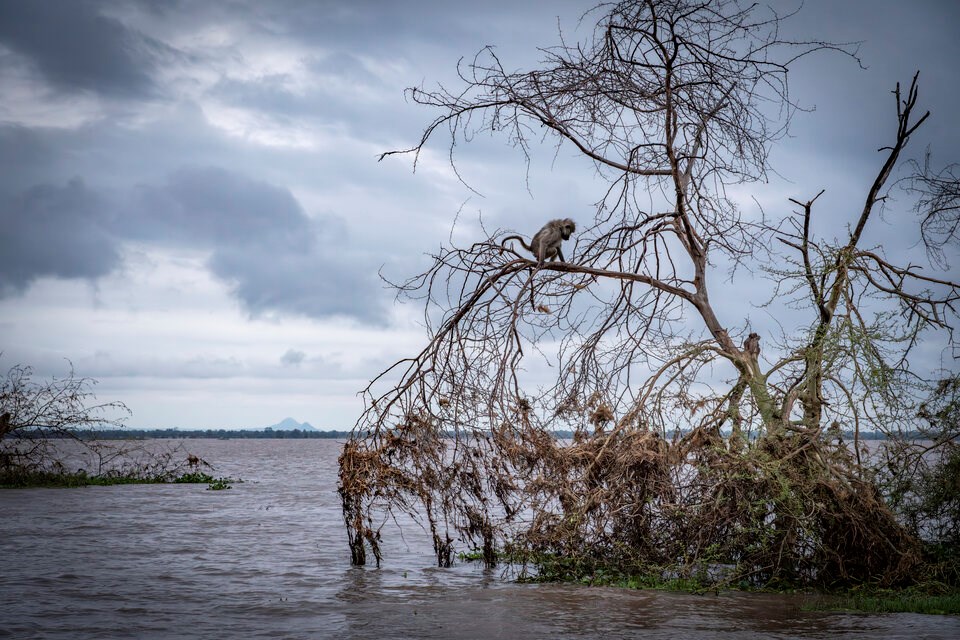Kaitlyn Gaynor picked her way through the woodlands of central Mozambique, stopping only to mount a camera to one many tree trunks ringing the floodplain of Lake Umera.
During the wet season, Gorongosa National Park's largest lake bursts its banks, flooding the flat landscape. When it recedes, grasses spring from the rich silt, drawing herds of elephants, buffalo and antelope. Prides of lion follow close behind.
“You need to be pretty vigilant. It's not just like an easy walk in the woods,” said Gaynor.
This part of the East African Rift Valley has been home to mega-fauna for millennia. But by 1992, a decade and a half of civil war had decimated wildlife, with hunting killing as much of 90 per cent of area’s large animals. Since then, conservation efforts have helped many species bounce back.
When Gaynor, an assistant professor in zoology and botany at the University of British Columbia, installed a grid of motion-activated camera traps in 2016, the idea was to track when animals moved and where they went. Little did she know then, the cameras would form a key window on how mega-fauna is adapting to mega-storms increasingly threatening ecosystems across the planet.
Animals run for their lives
On March 14, 2019, tropical cyclone Idai spun off the Indian Ocean, making landfall about 75 kilometres south of the park’s borders. As the storm swept through cities and the countryside, it brought torrential rains and winds blasting at 177 kilometres per hour.
An estimated 1,500 people died across Mozambique and neighbouring Malawi and Zimbabwe, making it the second-deadliest storm in the modern global record.
Animals were not spared. Near the shores of Lake Urema, flood waters stood six metres deep in some places — almost triple normal annual flood levels.
Before the storm, some of Gaynor’s colleagues in the area had collared seven large animal species with satellite tracking devices to understand their behaviour. Together with helicopter surveys, a careful analysis of animal scat and Gaynor’s grid of camera traps, the scientists started to piece together how the animals responded to the unprecedented storm.
The data and images came back showing an ark of animals in flight — from prides of lions and packs of wild dogs to herds of elephant, wildebeest, impala and kudu.
“There were pictures of animals kind of wading through water,” said Gaynor. “We were actually able to watch, almost in real time, the moving paths that they were taking as the floodwaters rose.”
In floodwaters, size matters
Last week, Gaynor and 17 of her colleagues — some from universities like Princeton and Yale, many from the park’s Department of Scientific Services — published their findings in the journal Nature.
Past studies carried out in the 1990s, found bigger, more mobile Bahamian lizards and spiders did a better job surviving hurricanes. That gave the researchers an idea of what to expect. But this was the first time scientists had a snapshot of mega-fauna survival before, during and after a catastrophic tropical cyclone.
When Gaynor finally returned in 2021, the floodplains she tramped through to set up cameras years ago had radically changed. She said many of the plants that drew the animals to the area died off in the floods. Small creatures such as termite mounds, were wiped out.
A small-bodied antelope, known as bushbuck, rely on floodplain grasses. Many drowned in the storm, stranded on quickly vanishing islands of dry land with nowhere to go.
Others lost body fat and uncollared individuals are thought to have died of malnutrition as their food source failed to return or they became prey to recently reintroduced carnivorous African wild dogs. Once plentiful, the species has lost roughly half its population in recent years, the study found.
Of the seven species they tracked, the three smallest species died immediately after the cyclone made landfall.
Other mammals like elephants and buffalo tended to take the storm in stride. Both species are used to walking long distances every day. They are good swimmers, and when required, their larger bodies tend to keep them clear of floodwaters so they can escape to higher ground.
In short, said Gaynor, “The bigger you were, the better you fared.”
Climate-driven storms could reshape ecosystems around the world
The results offer a window on how large animals withstand high-intensity storms. The study ultimately showed big storms produce winners and losers. For some animals, how they cope during big disturbances may no longer be adequate.
In the face of climate change or direct human threats on the landscape, many animals don't have time to evolve responses to survive. Their ability to change their behaviour quickly, not evolution, becomes a deciding factor between life and death.
For certain animals, a combination of their behaviour, diet, body size and movement patterns allow them to adapt, persist and even thrive through catastrophic flooding.
Those who have the right traits to survive will likely come to reshape the world they live in, Gaynor said. She says identifying those survival traits will help conservation scientists help wildlife get through big storms around the world.
“Obviously, you know, we don't have elephants in British Columbia,” she said. “But with climate change, we're seeing an increase in both the frequency and severity of extreme weather events — be they storms and floods or droughts or fires or heat waves.
“And so we're seeing this, not just in Africa, but all around the world, even in B.C.”





